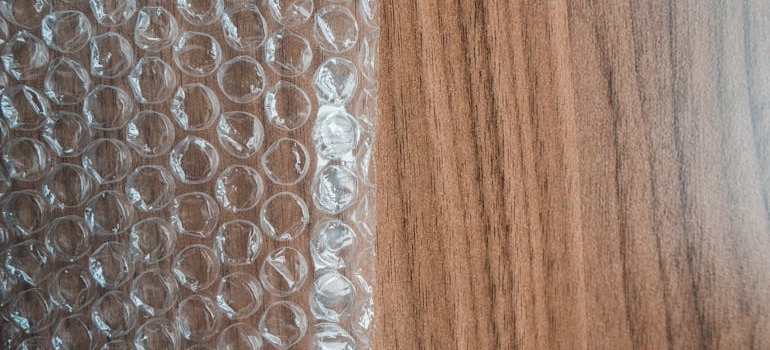How to Prepare Your Home for Movers
Getting your home ready for movers is an essential step in the moving process that can greatly influence the overall experience. With the right preparation, you can make moving day a seamless and efficient event, allowing you to focus on the excitement of your new beginning. Besides, properly preparing your home not only helps ensure that everything goes smoothly but also minimizes stress and protects your precious belongings from potential damage. Just imagine the peace of mind you’ll have, knowing that you’ve taken the necessary steps to safeguard your items and make the transition to your new home as easy as possible. Here’s a detailed Hansen Bros. Moving & Storage guide on how to prepare your home for movers, making the entire process infinitely more enjoyable!
1. Declutter Your Home
Before you even start packing, it’s important to declutter your home. It reduces the number of items you need to move and makes packing and unpacking easier. Start by going through each room and sorting your belongings. Decide what you want to keep, what can be donated, what can be sold, and what should be thrown away.
This is a great opportunity to get rid of items you no longer need or use. For items that are still in good condition, consider donating them to a local charity or organizing a garage sale. Selling items online through platforms like Craigslist, Facebook Marketplace, or eBay is also an option.
Decluttering not only reduces the volume of items your Washington movers need to move but can also be a cathartic process. It helps you to start fresh in your new home without the burden of unnecessary items. Plus, less stuff means lower moving costs, as most moving companies charge based on the weight or volume of your belongings.

2. Organize and Inventory Your Belongings
Creating an inventory list is a smart way to keep track of your items. This list can help ensure nothing gets lost during the move and can be useful for insurance purposes. Organize your list by room and include a description of each item. Take photos of valuable items as a visual record of their condition before the move. This documentation can be crucial if you need to file a claim for any damages.
Having an inventory list also helps you keep track of what you have and where it is. This is especially helpful if you’re moving to a larger home and might not unpack everything right away. Knowing which boxes contain essential items will make your first few days in the new house much more manageable.
3. Packing Efficiently
Packing is one of the most time-consuming aspects of moving, so start early. Gather all necessary packing supplies, including boxes, packing tape, bubble wrap, and markers. Use sturdy boxes of various sizes to accommodate different items:
- Books: Use small boxes for books, as they can get very heavy. Stack books flat to protect their spines.
- Clothing: Wardrobe boxes are ideal for hanging clothes. For folded clothes, use medium-sized boxes or even suitcases.
- Kitchenware: Wrap each item individually and use dish pack boxes with cell dividers for glasses and dishes.
- Electronics: Pack in original boxes if available. If not, use plenty of bubble wrap and padding. Take photos of wiring setups for easy reassembly.
- Artwork and Mirrors: Use special picture boxes and protect the front with cardboard. Bubble wrap and corner protectors are essential.
Pack room by room to stay organized as you prepare your home for movers. Label each box with its contents and the room it belongs to. This will help one of the best shipping companies Seattle has to offer to know where to place each box in your new home and make unpacking easier for you. For fragile items, use plenty of bubble wrap and mark the boxes clearly as “fragile.” Fill empty spaces in boxes with packing paper or towels to prevent items from shifting during transport.
4. Prepare Large Items
Large items such as furniture, appliances, and electronics need special attention. For furniture, disassemble what you can, such as bed frames, tables, and shelving units. Keep all screws and small parts in labeled bags and tape them to the corresponding piece of furniture. Next, consider the following preparation tips:
- Couches and Chairs: Protect upholstery with plastic wrap or moving blankets. Remove legs if possible.
- Tables and Desks: Remove legs and protect surfaces with moving blankets.
- Beds: Disassemble bed frames and wrap mattresses in mattress covers.
- Wardrobes and Dressers: Empty contents if they are heavy, but lightweight items can remain inside. Secure drawers with plastic wrap.
For electronics, pack them in their original boxes if possible. If not, use sturdy boxes and plenty of padding. Take photos of the wiring setup before disconnecting them to make reassembly easier. And for appliances, unplug and defrost your refrigerator at least 24 hours before moving. Secure all cords and hoses with tape to prevent them from dragging or getting damaged.

5. Clear and Clean Pathways
On moving day, make sure all pathways are clear for the movers. This includes hallways, stairs, and doorways. Move any furniture, rugs, or other obstacles out of the way. It speeds up the process and helps prevent accidents. If your home has narrow doorways or stairs, inform your local movers in Seattle in advance. They may need special equipment or additional help to move larger items safely.
Additionally, protect your floors by placing mats or old blankets in high-traffic areas to avoid scratches or dirt. Clearing pathways not simply helps the movers but also protects your home from damage. Removing obstacles and covering floors can prevent accidents and minimize the risk of injury.
6. Plan for Pets and Children
If you have pets or young children, it’s best to make arrangements for them on moving day. The hustle and bustle of moving can be stressful and even dangerous for them. Consider having a friend or family member take care of them, or hire a sitter for the day while you prepare your home for movers.
Keeping pets and children out of the way not only keeps them safe but also allows you to focus on overseeing the move. It can be challenging to manage movers while also keeping an eye on kids or pets, so having a plan for their care is crucial.
7. Communicate with Movers
Clear communication with your moving company is essential. Provide them with all the necessary details about your move, including any special instructions or concerns. This includes informing them about fragile items, large furniture, and any items that need special handling. Be present on a moving day to oversee the process and answer any questions the movers may have.
Checking everything with the team leader can help clarify any last-minute details and ensure everything is handled correctly. Good communication helps avoid misunderstandings and ensures that your belongings are handled with the care they require. If you have any specific requests, make sure to communicate them clearly to the moving team.
8. Final Preparations
Before your chosen cross country movers in Seattle arrive, do a final check to ensure everything is packed and ready. Make sure all boxes are labeled, and fragile items are properly protected. If you’ve packed a “first-night” box with essentials, keep it separate so it doesn’t get loaded onto the truck.
Also, ensure that all utilities are disconnected and that nothing is left behind. Lock all windows and doors and make sure your old home is secure. Doing a final walkthrough of your home can help you catch any items you might have missed and ensure that everything is in order before the movers arrive. This last check is a good time to verify that all your preparations are complete.
9. Prepare for Payment and Tipping
Finally, be prepared to settle the bill with the moving company. Have cash or a check ready if that’s how you’re paying. If you’re satisfied with the service, consider tipping the movers. While tipping is not mandatory, it’s a good way to show appreciation for their hard work.
Preparing your home for movers requires careful planning and attention to detail. Simply by following these steps, you can ensure that the moving process goes as smoothly as possible. A well-organized move not only saves time and money but also helps reduce stress, making your transition to a new home a positive experience.

Additional Tips and Insights
While the main steps cover the essentials, there are additional considerations to make as you prepare your home for movers. They can further streamline the process and address specific concerns. From understanding your rights and protections to handling specialized items, these extra steps can make a significant difference in your moving experience. Paying attention to these details can help prevent unexpected issues and ensure that every aspect of your move is thoughtfully managed.
Insurance and Liability
When hiring a moving company, it’s important to understand the insurance options available. Most moving companies offer different levels of protection. Basic coverage is often included in the moving fee, but this may only cover a fraction of the value of your items. For full coverage, consider purchasing additional insurance.
Beyond insurance, ensure that the moving company adheres to safety standards. That includes proper handling of heavy items, securing fragile goods, and following best practices to prevent accidents. Prioritizing both insurance and moving safety can provide peace of mind and protect your valuables during the move.
Special Items
Items like pianos, pool tables, or large safes require special handling. Inform the movers about these items ahead of time so they can bring the necessary equipment and manpower. These items often need to be disassembled and reassembled, and professional movers have the expertise to handle them safely.
Address Changes and Utilities
Don’t forget to update your address with the post office, banks, and other important institutions. Schedule the disconnection of utilities at your old home and the connection at your new home. This ensures you have all the essential services running smoothly when you move in.
Handling Sentimental Items
Items with sentimental value, such as family heirlooms, photographs, and important documents, should be packed separately and handled with extra care. Consider transporting these items yourself to ensure they are safe.
If the thought of packing is overwhelming, consider hiring professional packers. Many moving companies offer packing services. Professional packers can efficiently and safely pack your belongings, saving you time and effort. This service is especially useful for busy individuals or families with a large amount of belongings.

Cleaning Your Old Home
Leaving your old home clean is a courteous gesture, especially if you’re selling it or ending a rental lease. After you prepare your home for movers and everything is packed and moved, take the time to clean. This includes vacuuming, wiping down surfaces, and cleaning bathrooms. Some moving companies offer cleaning services as part of their package, so inquire if this is something you would like assistance with.
Moving Day Essentials
On a moving day, keep a small toolkit handy. This should include a box cutter, scissors, screwdrivers, and any other tools you might need for last-minute disassembly or assembly. Also, have snacks and drinks available for yourself and the movers.
The Importance of a Moving Checklist
Creating a moving checklist can help keep you organized. Start this checklist well in advance of your move with movers in Issaquah WA. Include tasks such as booking the moving company, gathering packing supplies, notifying utility companies, and scheduling final walk-throughs. A checklist ensures that you don’t forget important details and helps keep the process on track.
Ensuring a Smooth and Stress-Free Move
If you thoroughly and thoughtfully prepare your home for movers you can transform the moving process into a more efficient and less stressful experience. The guide offers an in-depth look at the critical steps involved, from decluttering and packing to effectively communicating with movers and completing final preparations. Planning and organizing every detail can ensure a successful transition to your new home, making the move as seamless and stress-free as possible.
Why Choose Us
History
Hansen Bros. Moving & Storage is locally owned and operated by the same family for four generations, since 1890. We have a well-established reputation for service quality and reliability with a high percentage of repeat household and commercial clients.
Professionalism
We’re a certified ProMover by the American Moving and Storage Association with A+ rating with the Better Business Bureau, voted “Best in Western Washington” in 2009 and from 2011 to 2016 by KING5. Our company is fully licensed and insured and member of WMC and AMSA.
Value
Hansen Bros. Moving & Storage provide free, no-obligation in-home estimate and competitive rates, including low minimum rates for shipments moving under 300 miles. We’ve set a refund policy for unused packing materials and three Puget Sound locations to help clients save on travel fee costs.



